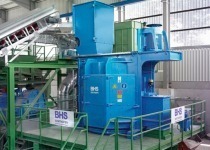Two-roller comminution
Comminution technology distinguishes between coarse, fine and ultra-fine comminution. Comminution machines are classified into impact, compressive, shearing and cutting systems, depending on their mode of force application. Combinations of these individual types are also known.
Roller crushers are coarse comminuting machines. They are generally used for the preparation of hard, brittle products, with synchronised rollers, and degrees of comminution of approx. 1:4 to 1:10, depending on the particular task. The form of force application in this case is purely compressive. Roller diameter is determined by the degree of comminution and the given product specification. Mean circumferential speed is a function of the necessary moment of inertia. At speeds of between 4 and 8 m/sec, wear rate remains within reasonable limits for the product processed.
Without intake aids (roller teeth, etc.), ultimate particle size is around >5 to 15 mm. The degree of comminution can be raised significantly by the use of additional intake aids of various sizes, shapes, materials and distributions on the rollers. When high rates of wear must be expected, in the case, for example, of processing of hard brittle products, such as monitor screen glass, ferrous products, quartz, feldspar, crushed rock, carbon elements, etc., segmental liner plates can be used to minimise downtimes. These can be changed during comminution, and repaired again outside the machine by means of hard-face welding. This keeps long-term operating costs low. Various rollers/segment materials can be selected, such as chromium-nickel steels, manganese steels, C45 hardened materials, etc., depending on the product. Roller crushers are used as the pre-comminution stage in preparation-process chains (Fig.).
Roller mills perform the task of fine comminution. At a degree of comminution of 1:4 to 1:6, the lower limit for the ultimate particle sizes is > 0.3 to approx. 1.0 mm. Hard brittle products, such as minerals, refractories, quartz, carbon elements, glass, silica products, etc., can be processed with roller synchronisation, and/or at low friction levels. The rule is: the smaller the gap, the greater the friction. For abrasive, generally brittle and hard products, it is between 1:1.1 and 1:1.5. The most diverse range of materials are also used for roller mills. Wall thicknesses of up to 60 mm permit repair of the rollers in case of dishing or scouring. Depending on the product processed, campaign lengths of up to one to two years between overhauls are no rarity. Potentially higher first costs compared to high-speed mill systems are balanced out by flexibility, high availability and low maintenance needs.
In chemicals industry applications, these machines process dry products with a low residual moisture content. These materials may thus be slightly lubricating or visco-elastic. The roller mills are then operated at frictions of between 1:1.5 and max. 1:3, depending on degree of comminution and ultimate particle size. This promotes roller self-cleaning, with assistance from scraper systems. Both standard straight scrapers and rotating scrapers in the form of brushes or screws are in use. Artificial fertilisers, soda, compacted salts, detergent ingredients, and industrial or edible salts may be mentioned as typical products. Due to their fine-comminution function, roller mills are generally equipped with smooth or fluted rollers. Components in contact with the product, such as housings, core plates and rollers, are available in high-quality steels. Corrosion-resistant stainless steels are used for salt products, for example. Roller mills are not infrequently operated as wet mills for processing of run-of-mine salts, i.e. as a preparation for washing. The general difference between roller crushers and roller mills can be found not in the mode of force application, but instead in the design. Roller crushers are equipped with a foreign-body or overload protection system, implemented by means of spring arrangements. Roller mills additionally possess a hand-wheel adjustment system which is used to set the comminution gap with an accuracy of 0.1 mm. This permits precise modification of the particle-size bandwidth, tailored to the product specification. Digitisation by means of rotary position transducers combined with hydraulic locking permits effortless remote-controlled setting and correction of the comminution gap between the rollers to match the process and the product.
The most diverse range of modifications have been implemented up to now. Roller crushers/mills featuring internally cooled rollers are supplied for extreme operating conditions, such as the preparation of hot kiln-process products. Welds and bearings must be protected, in order to withstand temperatures of approximately 600 to 700 °C. Cross-sections and water flows are determined theoretically on the basis of heat transfer into the body of the roller. Gas-tight roller crushers and mills are used when additional nitrogen blanketing is necessary, in the case, for example, of sensitive explosive substances, such as rare earths, magnesium-containing products, etc.. The gas-tightness of these machines is around 300 to 400 mm Wg.
A further application is zero-iron comminution of (for example) ceramics and glass products. Ceramic roller shells permit only a limited, low degree of comminution, generally of not more than 1:1.5. Combination with a “smart” control system and motor-driven gap adjustment makes it possible to multi-stage comminute products in batches to the required ultimate particle size via a grinding and screening circuit incorporating a roller mill. The system principle, known as “program-controlled grinding and screening” (PGS), permits flexible operation, i.e. as required for the diverse application tasks. In case of frequent product changes, for example, adjustments to the program permit production of the various particle-size fractions required. The table provides information on a range of examples of production of a product with the lowest possible fines content by means of pre- and final comminution using two-roller crushers/mills.







